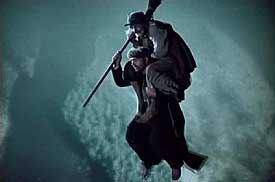 FFrom the 1835 novella by Nicolai Gogol, the supernatural horror of Viy; or Vij; aka, The Spirit of Evil (1967) is brought to the screen preserving the original story's folkloric sensibility.
FFrom the 1835 novella by Nicolai Gogol, the supernatural horror of Viy; or Vij; aka, The Spirit of Evil (1967) is brought to the screen preserving the original story's folkloric sensibility.
Seminarians on holiday are not the least monkish, but steal & drink & lust like they've no tomorrow.
On their way back to the monastary, in night & mist, three of these rowdy young men become lost. They find a a witchy old woman's farmhouse.
She gives them separate places to sleep the night. When all is quiet, she sneaks into the barn & climbs onto the back of one of the lads, whipping him with her broom until he runs outside & leaps flying into the sky.
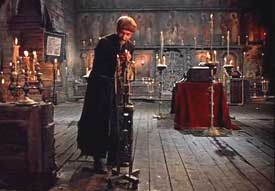 Upon landing, he finds a stick & tries to beat the old woman to death, stopping only when she turns into a beautiful young woman. He flees, bruised & dirty, back to the seminary. Upon landing, he finds a stick & tries to beat the old woman to death, stopping only when she turns into a beautiful young woman. He flees, bruised & dirty, back to the seminary.
This seminarian is Khoma Brutus (Leonid Kuravlyov), an orphan who has grown up in the monastary. The priest selects him to send to give prayers to the deceased Pannochka (Natalia Varley), daughter of a wealthy landholder. She's the very woman from whom he fled the night before.
When Khoma arrives at the landholder's church, the girl is laid out in death. Khoma is instructed pray three nights running, alone in the presence of the corpse, so that her soul will not be lost over the sins of her life. He is locked in the church with the corpse, as good as imprisoned until dawn.
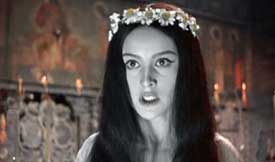 In the night the corpse rises, wanders the church, attempts to seduce the prayerful seminarian. In the night the corpse rises, wanders the church, attempts to seduce the prayerful seminarian.
The young man survives the harrowing experience from inside a sacred circle. At cockcrow the beautiful young witch returns to her coffin.
The second night, he braces himself for the experience with the aid of vodka. The girl's coffin flies about the church & tries to bash through the invisible barrier of the sacred circle.
She stands up in the flying coffin calling to Khoma who struggles not to heed her call. At cockcrow the coffin settles down.
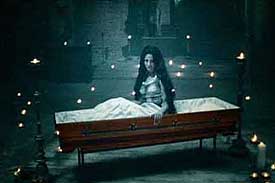 By day among the peasants & cossacks Khoma sings & dances to cast away gloom. But his hair has turned white & he's more fearful than ever facing the third & final night. By day among the peasants & cossacks Khoma sings & dances to cast away gloom. But his hair has turned white & he's more fearful than ever facing the third & final night.
That final night is a phantasmagoric carnival of horror, giant hands reaching, bizarre demons of all kinds, creatures scuttling down walls, dancing skeleton....a veritable parade.
Worst of all is the viy, which frightens even the winged & deformed demons. It's like an especially malformed golem with hypnotic gaze, & surviving to cock's crow seems especially unlikely for any sinner, which Khoma certainly is.
A true work of art, Viy falls halfway between fairy tale & horror story. As a "rustic" story, the simple FX & wild stagey costumes are perfectly realized to convey rusticity.
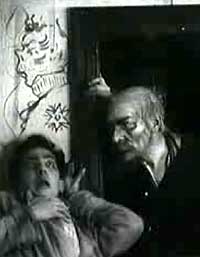 Russian filmmaker Vladislav Starevich is best remembered as a pioneer of puppet animation, but among his large early output are some live action films as well, including a one-reel adaptation of Nikolai Gogol's horror fantasy The Portrait (Portret, 1915). Russian filmmaker Vladislav Starevich is best remembered as a pioneer of puppet animation, but among his large early output are some live action films as well, including a one-reel adaptation of Nikolai Gogol's horror fantasy The Portrait (Portret, 1915).
Selecting a painting in a little artists' shop, our protagonist strolls home to his humble artist's garret with his purchase.
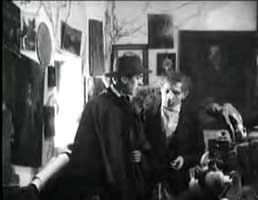 Having hung the portrait & dusted it with a cloth, the dusting changed the portrait inexplicably. Having hung the portrait & dusted it with a cloth, the dusting changed the portrait inexplicably.
The portrait transformed into a sinister figure which had to be covered with a blanket, so fearful was its gaze.
Happiness with the painting turns to disturbance as our hero finds it increasingly difficult to live with the portrait in his apartment. In his nightmare, it comes to life, staring at him hideously.
In another dream the sinister man climbed down from the portrait & lurked horribly by the protagonist's bed. The film ends abrupty with the protagonist at the height of unease.
The DVD release of Viy includes among the "extras" three silent horror films Queen of Spades (Pikovaya dama, 1916), Satan Exultant (Satana Likuyushchiy, 1917) & The Portrait, plus a Russian documentary Around Gogol Memorial Places undated but it's an old film.
From the early 1960s I would guess, the eighteen-minute newsreel-style documentary regards tourist spots associated with the life of Nikolai Gogol. We get scenes of St. Petersberg together with paintings & engravings that make it an illustratively effective little film, however inconsequential.
We're given vistas of rurual Ukraine, a biographical overview, & a bit of Soviet propaganda tossed on top for spice.
copyright © by Paghat the Ratgirl
|
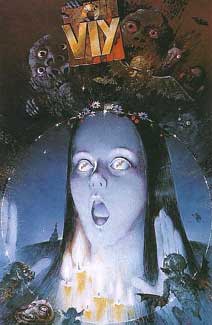

 Upon landing, he finds a stick & tries to beat the old woman to death, stopping only when she turns into a beautiful young woman. He flees, bruised & dirty, back to the seminary.
Upon landing, he finds a stick & tries to beat the old woman to death, stopping only when she turns into a beautiful young woman. He flees, bruised & dirty, back to the seminary. In the night the corpse rises, wanders the church, attempts to seduce the prayerful seminarian.
In the night the corpse rises, wanders the church, attempts to seduce the prayerful seminarian. By day among the peasants & cossacks Khoma sings & dances to cast away gloom. But his hair has turned white & he's more fearful than ever facing the third & final night.
By day among the peasants & cossacks Khoma sings & dances to cast away gloom. But his hair has turned white & he's more fearful than ever facing the third & final night.
 Having hung the portrait & dusted it with a cloth, the dusting changed the portrait inexplicably.
Having hung the portrait & dusted it with a cloth, the dusting changed the portrait inexplicably.